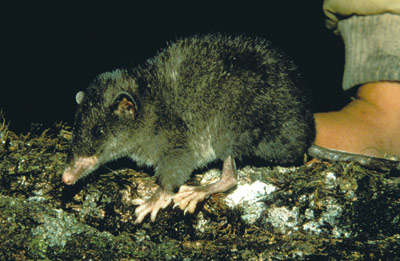Paucitubercolata & Caenolestidae -- The naming of the shrew opossums!
Caenolestidae



Origins
Paucitubercolata species have a unique feature in that each incisor has only one cusp or protruding bump on its crown. This is most unlike other mammal species hence the name which means "tuber teeth". The has only one extant family left : the Caenolestidae, meaning "new robber"; in this case the folks naming it were trying to say that this family is new with older characteristics. The members of this order are nocturnal and quite secrective. Add to that the fact that they are found in the high Andes, it makes them rather hard to point at and say coochiekoo(that's in case you wanted to do that anyway).
This order contains the six surviving species of shrew opossum: small, shrew-like marsupials which are confined to the Andes mountains of South America. It is thought that the order diverged from the ancestral marsupial line very early. As recently as 20 million years ago, there were at least seven genera in South America. Today, just three genera remain.
Physical Characteristics
Shrew opossums are about the size of a small rat (9 to 14 cm long), with thin limbs, a long, pointed snout and a slender, hairy tail. They are largely carnivorous, being active hunters of insects, earthworms and small vertebrates. They have small eyes and poor sight, and hunt in the early evening and at night, using their hearing and long, sensitive whiskers to locate prey. They seem to spend much of their lives in underground burrows and on surface runways. Largely because of their rugged, inaccessible habitat, they are very poorly known and have traditionally been considered rare. Recent studies suggest however, that they may be more common than had been thought.
Geographic Distribution
Caenolestids live in inaccessible forest and grassland regions of the High Andes. Other insectivores were entirely absent from South America until the Great American Interchange three million years ago, and are currently present only in the northwestern part of the continent. Shrew opossums have lost ground to the these and other placental invaders that fill the same ecological niches. Nevertheless, the ranges of shrew opossums and insectivores overlap broadly.
Reproduction
Very little is known about the particulars of breeding among shrew opossum species because of their rather secretive nature and geographic locations. It is generally considered that the breeding season begins in December and extends through to May. Silky Shrew opossums live in less cold climates and may have a longer breeding season. All these species are marsupials and so the new born are a bit underdeveloped when they are born. Litters can contain upto 4 individuals.
Feeding Habits
Caenolestids are believed to feed mostly on insects, but they have been seen to use their projecting lower incisors to repeatedly stab baby rodents (which they then ate). They forage in dense vegetation on the ground in dense, cold, and wet forests either at high elevations in the Andes or along the southern coast of Chile.
Species within Caenolestidae
Genus Caenolestes
Caenolestes caniventer (Gray-bellied Caenolestid)
Caenolestes condorensis (Andean Caenolestid)
Caenolestes convelatus (Northern Caenolestid)
Caenolestes fuliginosus (Dusky Caenolestid)
Genus Lestoros
Lestoros inca (Peruvian or Incan Caenolestid)
Genus Rhyncholestes
Rhyncholestes raphanurus (Long-nosed Caenolestid)